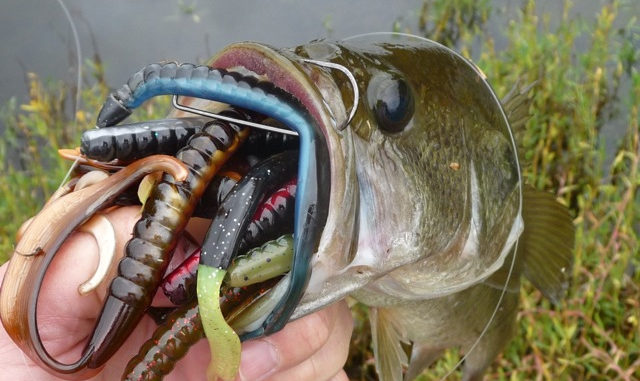
Show season is time to replace and add stuff
Now that we’re almost done watching football, it’s time to tackle something more important: your tackle. Every year, we faithfully voyage to several boat and tackle shows to see the latest and greatest gear and try to stay one step ahead of the fish. Looking at new boats, rods, reels and tackle is fun. The anticipation factor of buying that new lure keeps us hopeful that our next fishing trip will be better than the last.
So what do you need to look for when shopping for tackle? I know it can be overwhelming for many. I like to follow a somewhat orderly process when stocking up.
First, you need to go through your current tackle, everything from hooks, weights, rods and reels to lures. Make a list; start with hooks. Maybe you are need 4/0 wide-gap hooks or replacement trebles for your crankbaits. What about spinnerbait trailer hooks? Go through everything and think about what you don’t want to be without when you hit the water.
For soft plastics, make a list of your favorites and take inventory. One of my favorites is a 31/2-inch Culprit Incredicraw in Bama Bug — it works everywhere, so I make sure I have at least a hundred, and I re-order when I get down to about 20.
For hardbaits, I like to have at least three of each of my bread-and-butter baits, the ones I seem to fall back on over and over. Even topwater — you think you can’t lose them, but a couple of chain pickerel biting them off and forgetting to re-tie can leave you without a favorite when it really counts — I did that this past fall with a popper I really like.
For spinnerbaits and jigs, make sure the little rubber collars on the skirts are not dry rotted or else they will break in the heat of battle. Stock up on new baits and replacement skirts; Dave’s Tournament Tackle has the best selection of colors I’ve seen anywhere.
Repeat this for all your favorites, and you should have quite a shopping list before you even worry about buying anything new.
Once you have made your list of restocking standards, it’s time to think about new stuff. If you never try anything new, it is hard to learn new things and improve as an angler. Trying new stuff can be very expensive, as you may buy things that don’t work well. My advice is to try only one of anything new. Don’t give up on it after just a trip or two; try it in various water temperatures and clarity and maybe you will find a niche bait. I love finding these, as many fishermen will give up on a bait that may only work a couple of weeks a year. Often, these are the baits that will go out of production, so if you find one that works well — but other fisherman are not buying — it may be wise to stock up on them, as companies will stop making baits that don’t sell.
After you have taken care of restocking your favorites and have bought up all the latest and greatest, its time to think about what rods and reels you need to effectively fish all this stuff. Look at all your reels first; do you have some that are ruining your days on the lake? Get rid of the old ones that give you problems, and clean and lube your good ones. This will make your days on the water much more enjoyable.
Take a look at your rods as well. Replace broken guides and check for nicked ones with a Q-Tip. Make an honest assessment of what you have. Are your rods hurting your fishing? You may need to pick up some rods for specific techniques. Are you fishing with the right actions for the baits you are fishing? I feel you are almost always better off going a little heavier on the action that you think. A rod that is too “whippy” or too light can really hurt your hooksets — especially with worms and jigs. If you are losing a lot of fish, take a look at your rods first. The only reasons to get a light-action rod is for light lures and/or small hooks.
Finally, determining how you are going to organize and protect all this stuff is also important. If you fish in someone else’s boat, I suggest getting an over-and-under style tackle box as opposed to a bunch of small boxes in a bag. It is just easier to keep up with everything, and when it rains, you don’t come home with a wet bag. If you usually fish in your own boat — with tackle storage — a bunch of smaller plastic boxes are the way to go. For your rods, get the Rod Glove to protect them and keep them from getting tangled. Rod Glove also makes a neoprene Reel Glove that I especially like for spinning reels, as they are much more fragile than baitcasters. It is important the spools do not get nicked up, as your line can nick if they do.
So, when tackling your tackle this winter, have fun, focus on what works and don’t be afraid to try a few new things.



Be the first to comment